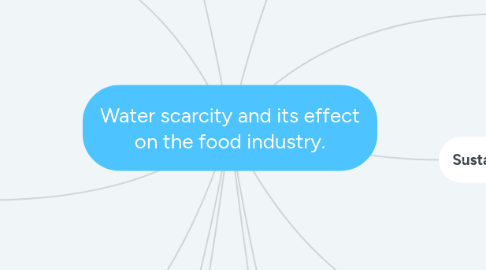
1. Water security
1.1. Growth and Development
1.1.1. Countries that achieved water security a long time ago are wealthier and dont deal with some of the great challenges that countries that did not fix their water security deal with.
1.1.1.1. The countries that did not achieve water security are facing great great challenges and difficult hydrologies.
1.1.2. countries that still have hydrology as a problem are typically among the world's poorest
1.1.2.1. they face difficuly hydrology issues including run off and other things and their invstment available to fix the problem is often low.
1.2. Research challenges and opportunities
1.2.1. 80% of the worlds (estimated) population is up against a risk of water security ow water related biodiversity.
1.2.2. a main challenge in the water security threats is the "challenge of balancing human and environmental water needs while safeguarding essential ecosystem services and biodiversity".
2. Economic
2.1. effects of multiple stressors on aquatic ecosystems under water scarcity
2.1.1. water scarcity can have a great effect on river ecosystems
2.2. impact of restricted water supply
2.3. The impact of water scarcity on economic development initiatives
2.3.1. discussed isse in south africa and the need for water security in order for ther to be growth and how to obtain that security.
2.4. AsgiSA
2.4.1. "objective of AsgiSA is to accelerate economic growth and seek to distribute the benefits thereof so that all people might share in the growing prosperity of the country"
3. Farming subsidies
3.1. reshaping environmental subsidies.
3.1.1. "fertile farmland should preferably be intensively farmed but sustainable targeted at high yields"
3.2. shrimp and salmon farming
3.3. resilience to water scarcity
3.3.1. study site of Doñana (southern Spain)
3.3.1.1. Since climate change can create problems and threats to already existing water scarcity risks, adapting and overcoming is crucial in order for agriculture to be able to adapt.
3.3.1.2. The average irrigation allocation for rice makes it the highest water consumption within the Guadalquivir basin.
4. soil and water conservation
4.1. performance of soil and water conversations
4.1.1. micro dams
4.1.1.1. They play a very crucial role towards increasing crop production in Northern Ethiopia because they can be built easily and quickly using available materials.
5. commercial agriculture
5.1. water requirements for social and economical development
5.1.1. "Existing estimates for water requirements vary between 20 and 4,654 l/c/d, but, these estimates are considered a problem because of method as they consider only human consumptive and hygiene needs, or they consider economic needs but not the effects of trade."
6. Food insecurity
6.1. Experience-based measures of food and water security
6.2. climate change and food security.
6.2.1. climate change can have a direct effect on crop production
6.2.2. changes in climate effect the growth and yield of crop plants
6.2.3. dramatic changes in temperature are often detrimental
6.2.4. "climate predictions in 2080 were obtained from various global circulation models (GCMs) and assessments made based on current populations and socio-economic conditions."
6.2.4.1. predictions are being made using science
7. Land use management
7.1. effects of multiple stressors on aquatic ecosystems under water scarcity. (TITLE OF ARTICLE)
7.1.1. water scarcity impacts river ecosystems
7.1.2. They are assesing the effects on the chemical and ecological status of freshwater ecosystems so they can improve water management practice and policies.
7.2. assessing land use impact on water resources.
7.2.1. they have a soil and water assessment tool they call swat for "assessing the relative impact of land cover change on hydrologic response."
7.2.1.1. they have found that land use changes have resulted in more surface runoff and less groundwater recharge.
8. water resources agriculture and environmental issues
8.1. water scarcity and environmental challenges
8.1.1. they said "the rules and use of irrigation water management under water scarcity must focus on specific objectives according to the causes of water scarcity"
8.1.1.1. A coupled environmental, economic, and social approach is necessary in valuing the water.
8.1.1.2. An integrated technical and scientific approach is crucial to create and use the correct irrigation management practices following close to demand and supply management.
9. Sustainability of Agriculture
9.1. Balancing water scarcity and quality for sustainable irrigated agriculture (title of site)
9.1.1. they say a strategy for increase in crops requires a better irrigated agriculture
9.1.2. they said "Irrigation presently amounts to nearly 70% of fresh water"
10. USDA policy
10.1. food security challenges and policies
10.1.1. new challenges to food security are posed by climate change
10.1.1.1. dramatic changes in climate or weather can result in pests and disease on crops and animals, as well as soil erosion and desertification.
10.1.2. they said "Achieving food security needs policy and investment changes in many areas, these areas being human resources, agricultural research, rural infrastructure, water resources, and changes in farm and community management.."
11. Drought periods/effects
11.1. impacts of droughts and floods on water security
11.1.1. Droughts and floods are having an affect on reducing household and national food availability
11.1.1.1. "in the food crisis year of 2001/2002," by "contrast, only 2.6% of households in our survey were self‐sufficient in maize, while 37% had less than three months, 70% had less than six months, and 92% had emptied their granaries after nine months." (copied from the site for percentage facts links will be in the source cited page)
11.1.2. harvests threaten food security and peoples livelihoods from a small scale and to a big scale like the nation these different levels depending on how much the household or the national depends on the food industry and agriculture.
11.1.3. the impacts of droughts and floods and rural markets are often negative.
12. Irrigation Technology
12.1. Agricultural economics and distributional effects
12.1.1. Agricultural economics and distributional effects

